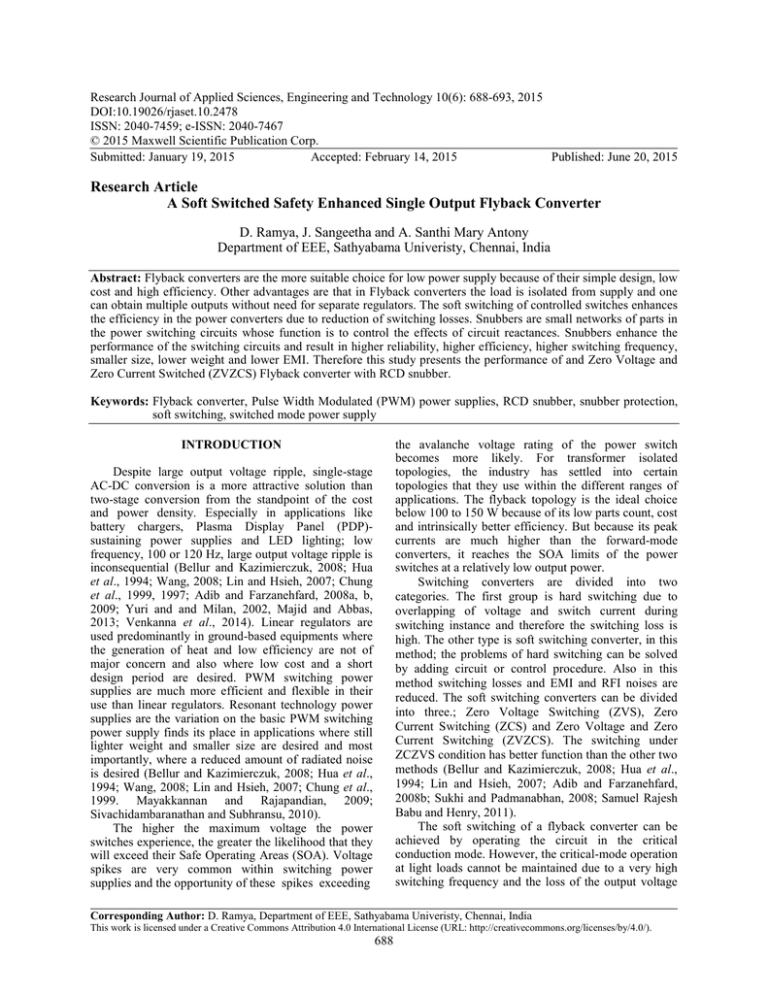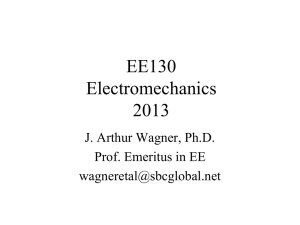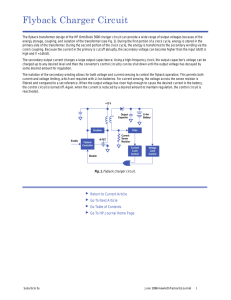Research Journal of Applied Sciences, Engineering and Technology 10(6): 688-693,... DOI:10.19026/rjaset.10.2478
advertisement

Research Journal of Applied Sciences, Engineering and Technology 10(6): 688-693, 2015 DOI:10.19026/rjaset.10.2478 ISSN: 2040-7459; e-ISSN: 2040-7467 © 2015 Maxwell Scientific Publication Corp. Submitted: January 19, 2015 Accepted: February 14, 2015 Published: June 20, 2015 Research Article A Soft Switched Safety Enhanced Single Output Flyback Converter D. Ramya, J. Sangeetha and A. Santhi Mary Antony Department of EEE, Sathyabama Univeristy, Chennai, India Abstract: Flyback converters are the more suitable choice for low power supply because of their simple design, low cost and high efficiency. Other advantages are that in Flyback converters the load is isolated from supply and one can obtain multiple outputs without need for separate regulators. The soft switching of controlled switches enhances the efficiency in the power converters due to reduction of switching losses. Snubbers are small networks of parts in the power switching circuits whose function is to control the effects of circuit reactances. Snubbers enhance the performance of the switching circuits and result in higher reliability, higher efficiency, higher switching frequency, smaller size, lower weight and lower EMI. Therefore this study presents the performance of and Zero Voltage and Zero Current Switched (ZVZCS) Flyback converter with RCD snubber. Keywords: Flyback converter, Pulse Width Modulated (PWM) power supplies, RCD snubber, snubber protection, soft switching, switched mode power supply the avalanche voltage rating of the power switch becomes more likely. For transformer isolated topologies, the industry has settled into certain topologies that they use within the different ranges of applications. The flyback topology is the ideal choice below 100 to 150 W because of its low parts count, cost and intrinsically better efficiency. But because its peak currents are much higher than the forward-mode converters, it reaches the SOA limits of the power switches at a relatively low output power. Switching converters are divided into two categories. The first group is hard switching due to overlapping of voltage and switch current during switching instance and therefore the switching loss is high. The other type is soft switching converter, in this method; the problems of hard switching can be solved by adding circuit or control procedure. Also in this method switching losses and EMI and RFI noises are reduced. The soft switching converters can be divided into three.; Zero Voltage Switching (ZVS), Zero Current Switching (ZCS) and Zero Voltage and Zero Current Switching (ZVZCS). The switching under ZCZVS condition has better function than the other two methods (Bellur and Kazimierczuk, 2008; Hua et al., 1994; Lin and Hsieh, 2007; Adib and Farzanehfard, 2008b; Sukhi and Padmanabhan, 2008; Samuel Rajesh Babu and Henry, 2011). The soft switching of a flyback converter can be achieved by operating the circuit in the critical conduction mode. However, the critical-mode operation at light loads cannot be maintained due to a very high switching frequency and the loss of the output voltage INTRODUCTION Despite large output voltage ripple, single-stage AC-DC conversion is a more attractive solution than two-stage conversion from the standpoint of the cost and power density. Especially in applications like battery chargers, Plasma Display Panel (PDP)sustaining power supplies and LED lighting; low frequency, 100 or 120 Hz, large output voltage ripple is inconsequential (Bellur and Kazimierczuk, 2008; Hua et al., 1994; Wang, 2008; Lin and Hsieh, 2007; Chung et al., 1999, 1997; Adib and Farzanehfard, 2008a, b, 2009; Yuri and and Milan, 2002, Majid and Abbas, 2013; Venkanna et al., 2014). Linear regulators are used predominantly in ground-based equipments where the generation of heat and low efficiency are not of major concern and also where low cost and a short design period are desired. PWM switching power supplies are much more efficient and flexible in their use than linear regulators. Resonant technology power supplies are the variation on the basic PWM switching power supply finds its place in applications where still lighter weight and smaller size are desired and most importantly, where a reduced amount of radiated noise is desired (Bellur and Kazimierczuk, 2008; Hua et al., 1994; Wang, 2008; Lin and Hsieh, 2007; Chung et al., 1999. Mayakkannan and Rajapandian, 2009; Sivachidambaranathan and Subhransu, 2010). The higher the maximum voltage the power switches experience, the greater the likelihood that they will exceed their Safe Operating Areas (SOA). Voltage spikes are very common within switching power supplies and the opportunity of these spikes exceeding Corresponding Author: D. Ramya, Department of EEE, Sathyabama Univeristy, Chennai, India This work is licensed under a Creative Commons Attribution 4.0 International License (URL: http://creativecommons.org/licenses/by/4.0/). 688 Res. J. Appl. Sci. Eng. Technol., 10(6): 688-693, 2015 regulation. A control which regulates the output down loads was proposed in Yuri and Milan ((2002). A soft switching pulse-width-modulated modulated fly back dc/dc converter with a simple auxiliary circuit was proposed by Majid and Abbas (2013). A multi--output Fly-back converter using a simple auxiliary circuit for soft switching was proposed in Venkanna et al al. (2014). This study presents a soft switched flyback converter with snubber protection and snubber capacitor which helps in achieving ZVS without additional capacitor in the circuit. to the zero load and maintains soft switching at light The circuit ircuit operates in two modes. When the switch is closed, energy is stored in the primary within the core material. The transformer secondary connections are made such a way that the diode in the secondary is reverse biased when the switch in the primary is closed. The equivalent circuit is during Mode 1 is shown in Fig. 2a. Therefore no energy is transferred from source to load during this interval. When the switch is turned off, the polarity of the primary voltage reverses due to the weakening of the magnetic tic field. Therefore the polarity of the secondary voltage of the transformer reverses which in turn forward biases the diode and hence energy stored in the core material is transferred to the load in Mode 2 as shown in Fig. 2b. The RCD Voltage age Snubber is applicable only to the clamp operation. A typical application of a resistorresistor capacitor-diode diode snubber is to control the rate of rise of voltage on the drain or collector of a switching SOFT SWITCHED FLYBACK CONVERTER The proposed circuit is shown in Fig. 1. The AC supply is rectified using uncontrolled rectifier and the rectifier output is smoothened using a capacitor and regulated using zener diode. This DC voltage is fed to flyback converter. The load is connected in the secondary of flyback transformer. RCD snubber is used as turnoff snubber and a capacitor snubber is used as turn on snubber. Fig. 1: Soft switched safety enhanced flyback converter (a) 689 Res. J. Appl. Sci. Eng. Technol., 10(6): 688-693, 2015 when the switch is closed (b) mode 2-when the switch is turned OFF Fig. 2: (a) Mode 1-when Fig. 3: Simulation circuit Table 1: System parameters Parameter Output power Input voltage Output voltage Output current Duty ratio Switching frequency Efficiency Magnetizing inductance Load resistance Rs Cs Cso Cf Co switching generates. When the resistor-capacitor-diode resistor snubber is used to control the rate of rise of voltage, the RC time constant must be short compared to the th switching frequency because the capacitor must be charged and discharged in each cycle: Value 265 W 230 V AC (peak) 85 V 3.15 A 0.6 50 kHz 85% 295 µH 44 17 27 Ω 8.16 k Ω 7 nF 4.7 nF 200 pF 1000 µF The output voltage (1) where, = Number of turns in the secondary = The number of turns in the primary = The DC link voltage The applied system parameters are given in Table 1. transistor in a forward, flyback or boost converter. At turn-off, off, the snubber will carry a major portion of the switch current and this transfers the power dissipation of the switch into the snubber. The reliability of the switch increases since its peak power dissipation is reduced and the he controlled rate of rise of voltage also lowers the high frequency EMI which the uncontrolled SIMULATION RESULTS The simulation is carried out in PSIM platform. The simulation circuit is shown in Fig. 3. The ac supply voltage is shown in Fig. 4. The Supply voltage and currents are shown in Fig. 5. The output of the rectifier/DC link voltage is shown in Fig. 6. The 690 Res. J. Appl. Sci. Eng. Technol., 10(6): 688-693, 2015 Vac 300 AC Supply-220 V(PEAK) 200 100 0 -100 -200 -300 0 0.02 0.04 0.06 0.08 0.10 Time (s) Fig. 4: AC supply voltage lac Vac 800 Lac-Source current 600 Vac supply voltage 400 200 0 -200 -400 0.06 0.04 0.02 0.08 0.10 Time (s) Fig. 5: Supply voltage and current Vdc 250 Vdc DC voltage 200 150 100 50 0 0 0.02 0.04 0.06 0.08 0.10 Time (s) Fig. 6: DC link voltage MOSFET switching pulses, current through the switch and switch voltages are shown in Fig. 7. The load voltage and load currents are shown in Fig. 7. Figure 8 shows output voltage and output currents. As observed from Fig. 7, during the instant of turn On of the switch the current through the switch is zero. Therefore the product of switch voltage and current is zero. This ensures that the turn ON power losses are zero. It is also observed from the figure that at the instant of turning OFF of the switch, the voltage across the switch is zero which ensures zero voltage turn off. The output voltage is 80 V and the output current is 2.9 A (Fig. 8). Though the converter is designed for 85 V output, since is voltage drop in the snubber circuit, the output voltage is reduced. CONCLUSION A ZVZCS Flyback converter was designed to deliver a power of 265 W. From the simulation results it is observed that the switching losses are zero. Since the turn on and turn off snubbers are used, it ensures the safety of the power device. Therefore the proposed configuration offers good efficiency. Further work can be extended to reduce the switching transients. 691 Res. J. Appl. Sci. Eng. Technol., 10(6): 688-693, 2015 Vpulse Switching pluses 1.0 0.5 0 Iswitch 12 Switching current 10 8 6 4 2 0 Vswitch 800 Voltage Acoss the swicth 600 400 200 0 0.03984 0.03986 Time (s) 0.03988 0.03989 Fig. 7: MOSFET switching pulses, current through the switch and switch voltages Vo Vo-Output Voltage 80 60 40 20 0 -20 0 0.02 0.06 0.04 0.08 0.10 0.08 0.10 Time (s) Lo Lo-Output Current 3.0 2.5 2.0 1.5 1.0 0.5 0 -0.5 0 0.02 0.04 0.06 Time (s) Fig. 8: Output voltage and output current 692 Res. J. Appl. Sci. Eng. Technol., 10(6): 688-693, 2015 Majid, D. and N. Abbas 2013. A new soft switching fly back DC-DC converter with minimal auxiliary circuit elements. Universal J. Elect. Electr. Eng., 1(4): 105-109. Mayakkannan, A.V. and S. Rajapandian, 2009. Closed loop controlled PFC boost converter fed DC drive. Int. J. Intell. Electr. Syst., 3(2). Samuel Rajesh Babu, R. and J. Henry, 2011. Embedded control ZVS dc-dc converter for eletrolyzer application. Int. J. Intell. Electr. Syst., 5(1). Sivachidambaranathan, V. and S.D. Subhransu, 2010. Closed loop controlled series resonant PFC DC-DC converter. Int. J. Intell. Electr. Syst., 4(1). Sukhi, Y. and S. Padmanabhan, 2008. 2008. Soft switching technique using resonant converter for constant speed drive. Int. J. Intell. Electr. Syst., 2(1). Venkanna, B., S.R. Viswanath and S. Pattnaik, 2014. Design and analysis of A new soft-switching multioutput fly-back converter. Proceeding of the IEEE Students Conference on Engineering and Systems (SCES), pp: 1-6. Wang, M., 2008. A novel ZCS PWM flyback converter with a simple ZCS PWM commutation cell. IEEE T. Ind. Electron., 55(2): 749-757. Yuri, P. and M.J. Milan, 2002. Adaptive off-time control for variable-frequency, soft-switched flyback converter at light loads. IEEE T. Power Electr., 17(4): 593-603. REFERENCES Adib, E. and H. Farzanehfard, 2008a. Family of zerocurrent transition PWM converters. IEEE T. Ind. Electron., 55(8): 3055-3063. Adib, E. and H. Farzanehfard, 2008b. Family of zero current zero voltage transition PWM converters. IET Power Electron., 1(2): 214-223. Adib, E. and H. Farzanehfard, 2009. Family of softswitching PWM converters with current sharing in switches. IEEE T. Power Electr., 24(84): 979-985. Bellur, D.M. and M.K. Kazimierczuk, 2008. Review of Zero-Current Switching Flyback PWM DC-DC Converters. Wiley. Chung, H., S.Y.R. Hui and W.H. Wang, 1997. An isolated soft switched flyback converter with low voltage stress. Proceeding of the Power Electronics Specialists Conference, pp: 1417-1423. Chung, H.C.H., S.Y.R. Hui and W.H. Wang, 1999. A zero current switching PWM flyback converter with a simple auxiliary switch. IEEE T. Power Electr., 14(2): 329-342. Hua, G., E.X. Yang, Y. Jiang and F.C. Lee, 1994. Zero current transition PWM converter. IEEE T. Power Electr., 9(6): 601-606. Lin, B.R. and F.Y. Hsieh, 2007. Soft switching zetaflyback converter with a buck boost type of active clamp. IEEE T. Ind. Electron., 54(5): 2813-2822. 693


